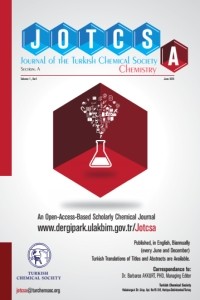Abstract
References
- 1. Kostova I, Saso L. Advances in research of Schiff-base metal complexes as potent antioxidants. Curr Med Chem. 2013; 20(36): 4609–32.
- 2. Sztanke K, Maziarka A, Osinka A, Sztanke M. An insight into synthetic Schiff bases revealing antiproliferative activities in vitro. Bioorg Med Chem. 2013; 21(13): 3648–66.
- 3. Maheswari PU, Roy S, den Dulk H, Barends S, van Wezel G, Kozlevcar B, et al. The square-planar cytotoxic [CuII (pyrimol) Cl] complex acts as an efficient DNA cleaver without reductant. J Am Chem Soc. 2006; 128(3): 710–11.
- 4. Qiao X, Ma Z-Y, Xie C-Z, Xue F, Zhang Y-W, Xu J-Y, et al. Study on potential antitumor mechanism of a novel Schiff Base copper(II) complex: synthesis, crystal structure, DNA binding, cytotoxicity and apoptosis induction activity. J Inorg Biochem. 2011; 105(5): 728–37.
- 5. Qin Q-P, Liu Y-C, Wang H-L, Qin J-L, Cheng F-J, Tang S-F, et al. Synthesis and antitumor mechanisms of a copper(II) complex of anthracene-9-imidazoline hydrazone (9-AIH). Metallomics. 2015; 7(7): 1124–36.
- 6. Ambundo EA, Deydier M-V, Ochrymowycz L, Rorabacher D. Kinetics and mechanism of copper(II) complex formation with tripodal aminopolythiaether and aminopolypyridyl ligands in aqueous solution. Inorg Chem. 2000; 39(6): 1171–79.
- 7. Jasiński R, Jasińska E, Dresler E. A DFT computational study of the molecular mechanism of [3+ 2] cycloaddition reactions between nitroethene and benzonitrile N-oxides. J Mol Model. 2017; 23(1): 13.
- 8. Siaka A, Adamu U, Sulaiman I, Hamza A, others. Density functional theory (B3LYP/6-311+ G**) study of some semicarbazones formation mechanism. Orient J Chem. 2015; 31(4): 1985–97.
- 9. Siakaa A, Uzairub A, Idrisb S, Abbaa H. DFT (B3LYP) computational study on the mechanisms of formation of some semicarbazones. Chem J Mold Gen. 2016; 11(1): 74–85.
- 10. Adeniji SE, Uba S, Uzairu A. A Novel QSAR Model for the Evaluation and Prediction of (E)-N’-Benzylideneisonicotinohydrazide Derivatives as the Potent Anti-mycobacterium Tuberculosis Antibodies Using Genetic Function Approach. Phys Chem Res. 2018; 6(3): 479–92.
Density Functional Theory (DFT) approach for kinetic and thermodynamic study of reaction mechanism of copper (II) complex from 2-hydrazinyl-4,5-dihydro-1h-imidazole and anthracene-9-carbaldehyde
Abstract
Abstract: A computational approach was employed to study the reaction
mechanism for the copper (II) complex from 2-hydrazinyl-4,5-dihydro-1H-imidazole
and anthracene-9-carbaldehyde at DFT (B3LYP) theory level. The reaction
mechanism was proposed and found to have five elementary steps which involve
intermediate elementary step and three transition state. The reaction
mechanisms are observed to have bimolecular and unimolecular steps which give
rise to two-step reaction pathway. The bimolecular step appeared to be rate
determining step with highest energy barrier (2925.75kJ/mol) at the third
transition state (TS3). The geometrical variations in bond length of the
intermediate and the transition states during the course of the reaction was
also studies which signified that transformation has occurred from the initial
state to final state of product formation. The rate equation and general rate
law for the reaction pathways were also established. The kinetics study shows
that the reaction mechanism for the formation of copper (II) complex follows
pseudo-first order and second order reaction with high correlation while the
thermodynamic study indicates that the overall reaction is non-spontaneous and
endothermic.
References
- 1. Kostova I, Saso L. Advances in research of Schiff-base metal complexes as potent antioxidants. Curr Med Chem. 2013; 20(36): 4609–32.
- 2. Sztanke K, Maziarka A, Osinka A, Sztanke M. An insight into synthetic Schiff bases revealing antiproliferative activities in vitro. Bioorg Med Chem. 2013; 21(13): 3648–66.
- 3. Maheswari PU, Roy S, den Dulk H, Barends S, van Wezel G, Kozlevcar B, et al. The square-planar cytotoxic [CuII (pyrimol) Cl] complex acts as an efficient DNA cleaver without reductant. J Am Chem Soc. 2006; 128(3): 710–11.
- 4. Qiao X, Ma Z-Y, Xie C-Z, Xue F, Zhang Y-W, Xu J-Y, et al. Study on potential antitumor mechanism of a novel Schiff Base copper(II) complex: synthesis, crystal structure, DNA binding, cytotoxicity and apoptosis induction activity. J Inorg Biochem. 2011; 105(5): 728–37.
- 5. Qin Q-P, Liu Y-C, Wang H-L, Qin J-L, Cheng F-J, Tang S-F, et al. Synthesis and antitumor mechanisms of a copper(II) complex of anthracene-9-imidazoline hydrazone (9-AIH). Metallomics. 2015; 7(7): 1124–36.
- 6. Ambundo EA, Deydier M-V, Ochrymowycz L, Rorabacher D. Kinetics and mechanism of copper(II) complex formation with tripodal aminopolythiaether and aminopolypyridyl ligands in aqueous solution. Inorg Chem. 2000; 39(6): 1171–79.
- 7. Jasiński R, Jasińska E, Dresler E. A DFT computational study of the molecular mechanism of [3+ 2] cycloaddition reactions between nitroethene and benzonitrile N-oxides. J Mol Model. 2017; 23(1): 13.
- 8. Siaka A, Adamu U, Sulaiman I, Hamza A, others. Density functional theory (B3LYP/6-311+ G**) study of some semicarbazones formation mechanism. Orient J Chem. 2015; 31(4): 1985–97.
- 9. Siakaa A, Uzairub A, Idrisb S, Abbaa H. DFT (B3LYP) computational study on the mechanisms of formation of some semicarbazones. Chem J Mold Gen. 2016; 11(1): 74–85.
- 10. Adeniji SE, Uba S, Uzairu A. A Novel QSAR Model for the Evaluation and Prediction of (E)-N’-Benzylideneisonicotinohydrazide Derivatives as the Potent Anti-mycobacterium Tuberculosis Antibodies Using Genetic Function Approach. Phys Chem Res. 2018; 6(3): 479–92.
Details
| Primary Language | English |
|---|---|
| Subjects | Chemical Engineering |
| Journal Section | Articles |
| Authors | |
| Publication Date | February 15, 2020 |
| Submission Date | February 15, 2019 |
| Acceptance Date | November 18, 2019 |
| Published in Issue | Year 2020 Volume: 7 Issue: 1 |



